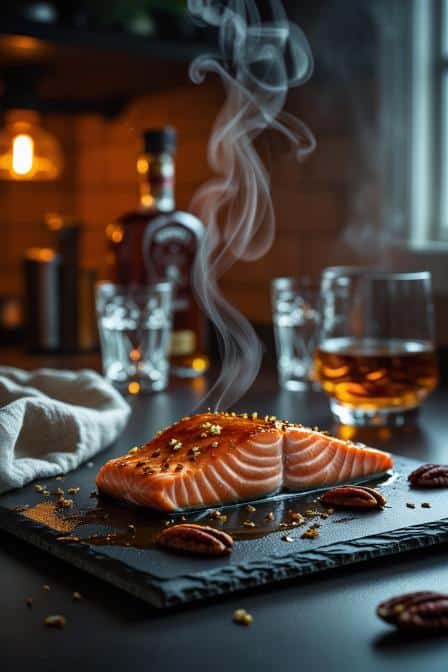You ever stand in front of your stove, fish fillet in hand, wondering, How do I make this thing sing? Not just cook it—elevate it. That was me, back in a smoky apartment kitchen in Louisville, trying to impress someone way outta my league. All I had was a hunk of salmon, a dusty bottle of bourbon, and a little too much ambition. But by the time that glaze hit the pan? Something magic happened.
That sticky-sweet bourbon glaze clung to the salmon like a velvet jacket on a blues singer. Rich, a lil’ fiery, mellowed with brown sugar and garlic, the whole thing tasted like dinner had gone and gotten all dressed up.
This recipe ain’t just salmon. It’s a whole experience. It’s date night and campfire and southern soul, packed into one ridiculously flavorful bite.
Let’s dig deep. You’ll wanna know why this works—not just how.
What Makes This Bourbon Glazed Salmon So Dang Special?
Bourbon glazed salmon ain’t your average Tuesday night dinner. It bridges the world of bold Southern whiskey notes with the delicate, buttery flesh of fresh salmon. The glaze itself is a balance of fire, sweet, tang, and depth—thanks to dark brown sugar, garlic, Dijon mustard, soy, and a kiss of lemon juice.
What’s unique? That thick lacquer of sauce, seared just enough to get those caramelized edges. You’re not just cooking here. You’re glazing. You’re letting sugar meet heat in a full-on dance.
And bourbon isn’t just there to sound fancy. The alcohol cooks off, but what you’re left with is this warm vanilla-oaky hum that wraps around the fish like a blanket.
You can grill it, pan-sear it, or broil it. You can even bake it low and slow if you’ve had that kind of day. It’s versatile, forgiving, and wildly impressive. But it does take some finesse.
Let’s start with what you’ll need.
Ingredients & Substitutions
Choosing the right stuff matters here. Use wild-caught salmon if you can. Bourbon? Don’t waste the expensive stuff, but don’t grab a bottle that tastes like paint thinner either. You want flavor, not fuel.
Here’s the lineup:
| Ingredient | Purpose | Substitutions & Tips |
|---|---|---|
| 4 salmon fillets (6 oz each) | Main protein | Can sub with steelhead trout or Arctic char |
| ½ cup bourbon | Glaze base | Use apple juice or non-alcoholic bourbon for booze-free |
| ¼ cup dark brown sugar | Sweet depth | Maple syrup or honey work too—just reduce slightly |
| 2 tbsp low-sodium soy sauce | Umami and salt | Tamari (GF) or coconut aminos if avoiding soy |
| 1 tbsp Dijon mustard | Adds tang and body | Grainy mustard or yellow if that’s all ya got |
| 1 tbsp lemon juice | Cuts richness | Apple cider vinegar in a pinch |
| 1 tsp garlic, minced | Aromatic base | Fresh is best; powder can do in a rush |
| 1 tsp cornstarch (optional) | Thickens glaze | Arrowroot or reduce more for a natural glaze |
| Olive oil, salt, pepper | For seasoning and cooking | Don’t skip seasoning the fish! |
Pro Tip: Always taste your bourbon before cooking with it. If it burns going down, it’ll burn in your glaze. Smooth and a lil’ sweet is what you want.
Step-by-Step Instructions
Alright, time to make magic. Keep your pan hot and your glaze hotter.
1. Pat the salmon dry
Water is the enemy of sear. Use a paper towel, get every side nice and dry. That’s what gives you that golden crust.
2. Season simply
Salt and pepper, that’s all. No need to overdo it. The glaze will carry most of the flavor, but don’t forget to season the underside too.
3. Make the glaze
In a small saucepan, combine bourbon, brown sugar, soy sauce, Dijon, garlic, and lemon juice. Medium heat. Stir gently.
Once it simmers? Lower heat and let it reduce. About 6–8 minutes, until it’s syrupy but still pourable. If you’re impatient, mix in a little cornstarch slurry (½ tsp cornstarch + 1 tsp water) and stir it in for thickness.
4. Sear the salmon
Heat a nonstick skillet over medium-high. Add a splash of olive oil. When the oil shimmers? Lay the fillets down, skin-side up (if they have skin).
Don’t touch it. Seriously. Let it sear 3–4 minutes until the bottom is golden and lifts cleanly.
Flip gently. Cook another 2–3 minutes on the other side.
5. Glaze it up
Spoon the glaze over the salmon, letting it bubble around the fillets. Tilt the pan and baste with a spoon. Cook another 1–2 minutes, letting that sauce cling to the flesh.
Want it sticky and lacquered? Turn off the heat and let the residual warmth finish the job.
Don’t overcook—salmon should be tender, flaky, and just barely translucent in the center.
Common Mistake: Glaze too early, and the sugars will burn. Always sear first, then glaze at the end.
Cooking Techniques & Science
Why sear first? Because you need a hot, dry surface to caramelize the proteins on the outside. That’s what gives you that Maillard reaction—deep, complex browning that smells like heaven in a cast iron pan.
The glaze is a reduction. As it simmers, the water evaporates, concentrating flavor and thickening naturally. Adding sugar helps it caramelize fast, and the mustard acts like a mild emulsifier—bringing the whole sauce together into a silky pour.
Don’t use high heat with the glaze for too long. Sugars burn fast. Low and slow is the way to go once that glaze hits the fish.
Tools That Help
- Cast iron or heavy-bottom skillet: Best for even searing
- Silicone brush or spoon: For glazing like a pro
- Fish spatula: Thinner edge = cleaner flips
Storage & Reheating
Got leftovers? Lucky you.
To store: Let cool fully, then transfer to an airtight container. Fridge up to 3 days.
To reheat: Gently warm in a nonstick pan over low heat with a splash of water or extra glaze. Microwaving dries it out, but hey—we’ve all done worse.
Don’t freeze glazed salmon. The glaze texture won’t hold up, and neither will the fish.
Variations & Substitutions
- Spicy kick: Add red pepper flakes or a teaspoon of Sriracha to the glaze.
- Gluten-free: Use tamari or coconut aminos instead of soy sauce.
- Vegan twist: Try on grilled tofu steaks or roasted cauliflower “steaks”—it’s insanely good.
- Maple Bourbon: Sub brown sugar for maple syrup for a deeper, woodsy sweetness.
Serving & Pairing Suggestions
Let’s make this look as good as it tastes.
Plate it with a swoosh of glaze underneath and a drizzle on top. Garnish with chives, lemon zest, or even toasted sesame seeds.
Best sides:
- Garlic mashed potatoes or sweet potato mash
- Roasted broccolini or green beans
- Herbed rice pilaf
- Warm buttered corn
Wanna make it fancier? Pair it with a glass of Pinot Noir or bourbon cocktail like an Old Fashioned. That smoky-sweet echo? Unreal.
Best Time to Serve or Eat This Dish
Dinner parties, date nights, or Sunday dinners when you want to feel fancy without the fuss. It’s rich enough for cold weather comfort but light enough for a summer night with grilled veggies.
Honestly though? Tuesday night with reruns and bare feet works just fine too.
Final Thoughts: Why This Recipe Just Works
There’s something real about the way salmon and bourbon glaze play together. It’s not trendy. It’s timeless.
The fish stays buttery. The glaze is bold but not overpowering. Every bite feels balanced—sweet, savory, rich, a touch tangy. And it all happens in one pan.
You don’t need a culinary degree to pull this off. You just need good ingredients, a hot pan, and the patience to not poke your salmon every five seconds.
Final tip? Don’t rush the glaze. Let it simmer until it speaks to you—thick, shiny, and just on the edge of sticky.
Cook it once, and you’ll find yourself buying salmon again just for this glaze. Trust me.
FAQs
1. Can I make the glaze ahead of time?
Absolutely. You can make the bourbon glaze 2–3 days ahead. Store it in the fridge in a sealed jar. Reheat gently before glazing.
2. What kind of bourbon is best for this recipe?
A mid-shelf bourbon with caramel and vanilla notes works best. Brands like Bulleit, Maker’s Mark, or Woodford Reserve are solid options.
3. Can I grill the salmon instead of pan-searing it?
Yes! Just grill the salmon until nearly done, then brush on the glaze and grill another 1–2 minutes to let it caramelize slightly.
4. Is it okay to use frozen salmon?
You can—just make sure it’s fully thawed and patted dry. Excess moisture will stop it from searing properly.
5. What if my glaze gets too thick?
Add a splash of water or bourbon while it’s still warm to thin it out. Glaze should be thick enough to coat a spoon, not clump.
Let the glaze do the talking. And let that bourbon warmth seep into every bite. This ain’t just dinner—it’s a moment.

